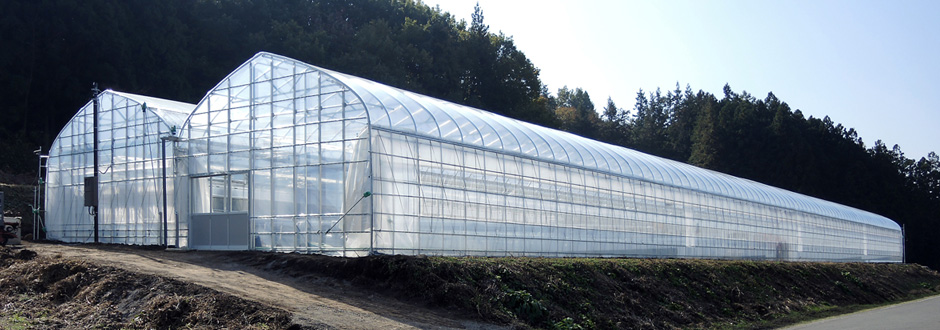
Coexisting with NatureA Construction Company is Growing Strawberries!
Shimizu, which is a construction company, has many faces. It is growing strawberries and working on other initiatives in the agriculture business with its sights set on the future of agriculture in Japan.
Growing Strawberries in Hokkaido
There is a huge vinyl-covered greenhouse on a vast plain in one corner of the industrial district in the eastern part of Tomokomai, Hokkaido. It is a strawberry farming site in which Shimizu participates. The owner of the site is Tomatoh Farm. The company was established through investments by multiple companies as a program promoting accelerated introduction of next-generation greenhouse technologies, an initiative supported by the Ministry of Agriculture, Forestry and Fisheries. Shimizu is one of the investors in the business and also helps to operate the facility.

Passing on Greenhouse Technologies to the Next Generation
The reason why the Ministry of Agriculture, Forestry and Fisheries originally started this
program was to switch to a next-generation agricultural model that would reduce costs through large-scale facility
consolidation, and that uses ICT-based environmental control technology.
The perspective of sustainability in
taking Japanese greenhouses to a next-generation level by engaging in efficient, planned production was also an
underlying factor.
We decided to participate in this business because sustainability is one of the key areas
important to Shimizu. It was also based on our ability to utilize the environmental management technology that
Shimizu has developed and the expertise in energy management that we have accumulated.

Maintaining the Optimal Environment for Growing Strawberries Year-round
Tomatoh Farm facilities include a closed seed production facility with artificial light, a large
greenhouse that utilizes sunlight, a wood-based biomass boiler facility, and a center for collection, shipping, and
management.
The goal is to make it possible to harvest strawberries regardless of the season by using
environmental control technology to maintain the optimal environment for growing strawberries year-round. The
expertise of the companies that have invested in the business is also used in production management, quality
control, labor management, and other aspects.


Year-round variety (Summer strawberries): Suzuakane
An Initiative that Will Lead to
Greater Self-sufficiency in Food
In addition to Tomatoh strawberries, Shimizu has teamed up with relevant
organizations and companies to work on large-scale cultivation of mini tomatoes and cucumbers.
Once we
succeed in applying our achievements in these initiatives to other crops, it will lead to a stable food supply
and, by extension, self-sufficiency in food for Japan.
We will continue to take on the challenges of the
agricultural business with that goal in mind.

Column
Regenerating Forests to Create a Hometown Environment
Another agricultural business that Shimizu is involved in is an initiative aimed at local production and
local consumption of forest resources in the village of Kawaba, in Gunma Prefecture. In Wood Village Kawaba, a
project in which Shimizu has invested and collaborates, the main activity is to produce and sell products made
of wood harvested by thinning 27,200 hectares of privately owned forest, then using the scrap wood that
results as fuel for biomass power generation. The waste heat from power generation is then used to cultivate
agricultural crops in greenhouses, and the increased volume of CO2 absorbed by forest regeneration
through thinning is turned into carbon credits.
This initiative is drawing interest from local governments
that are seeking to revitalize agriculture and generate employment as one useful way to revitalize their
communities.




The information posted here is the current information on September 1, 2017.
Please be aware that
this information may have changed by the time you view it.


